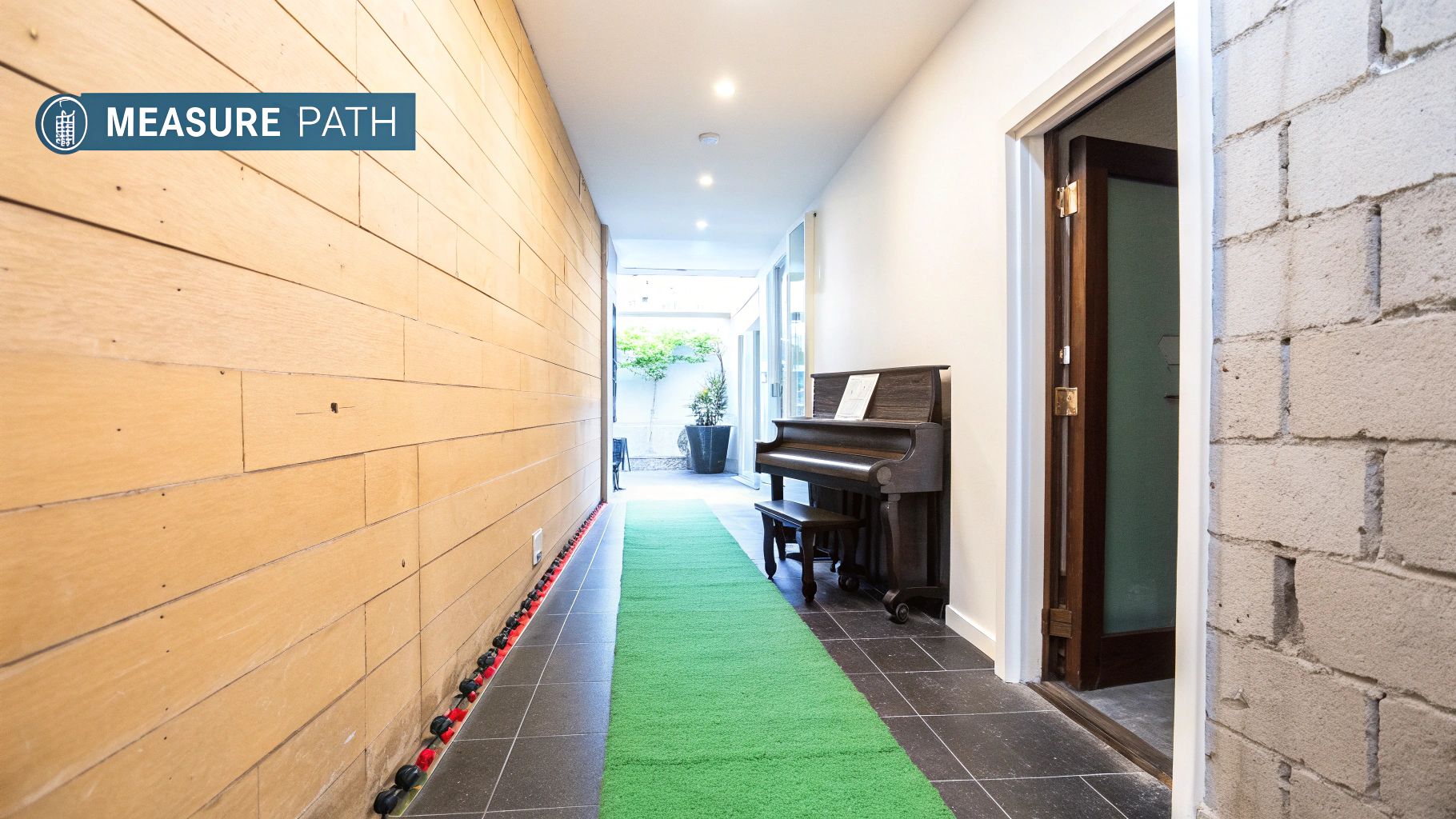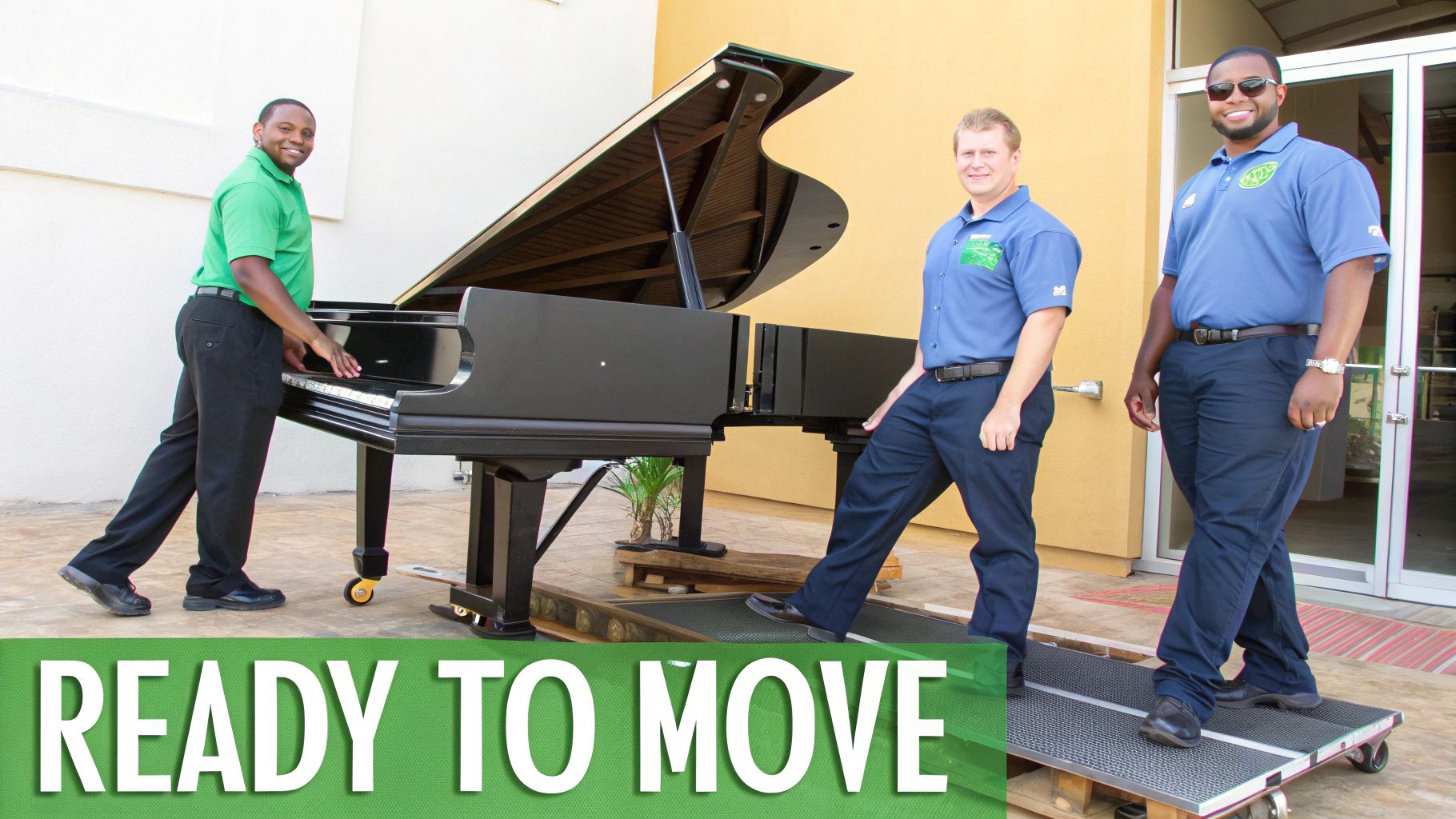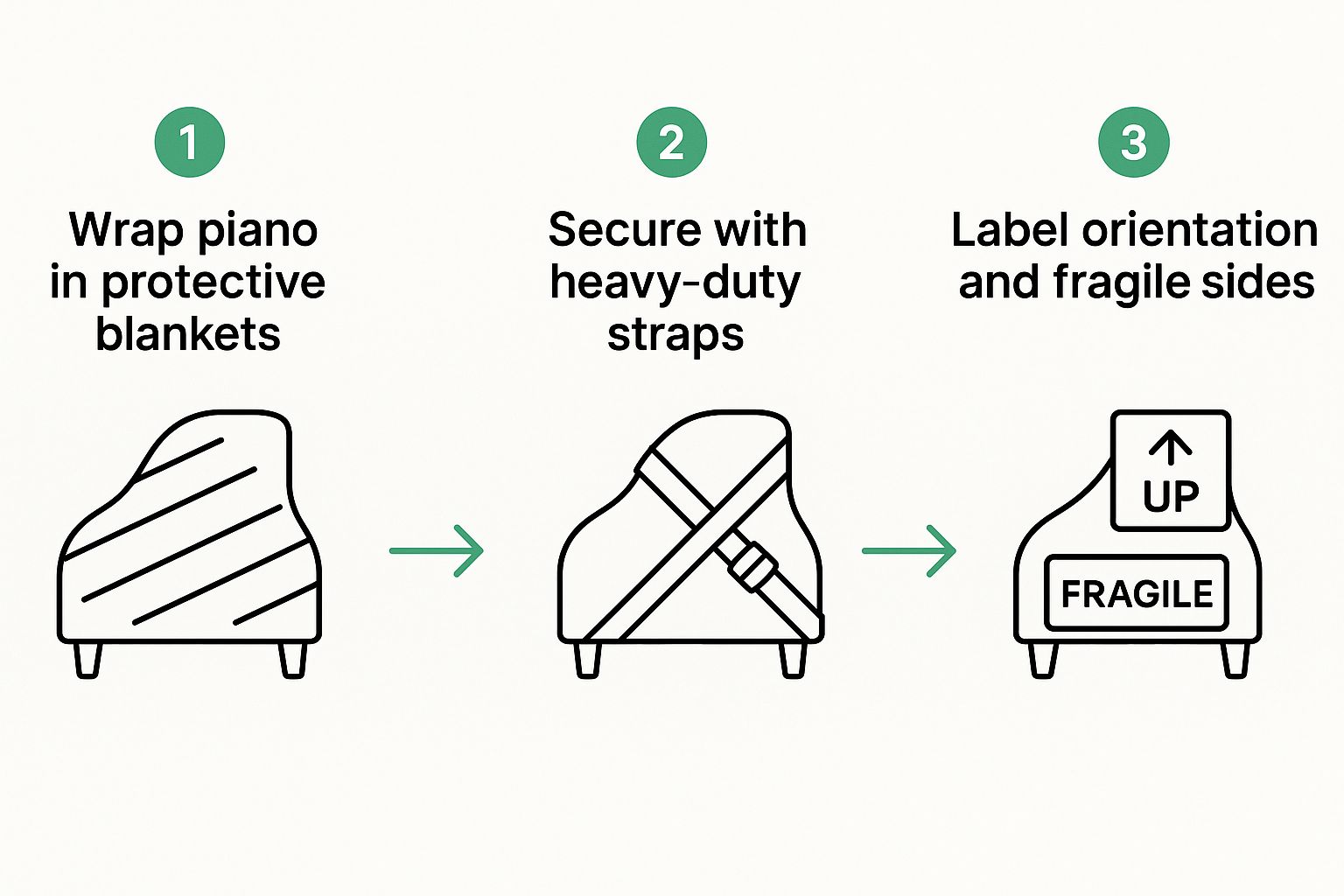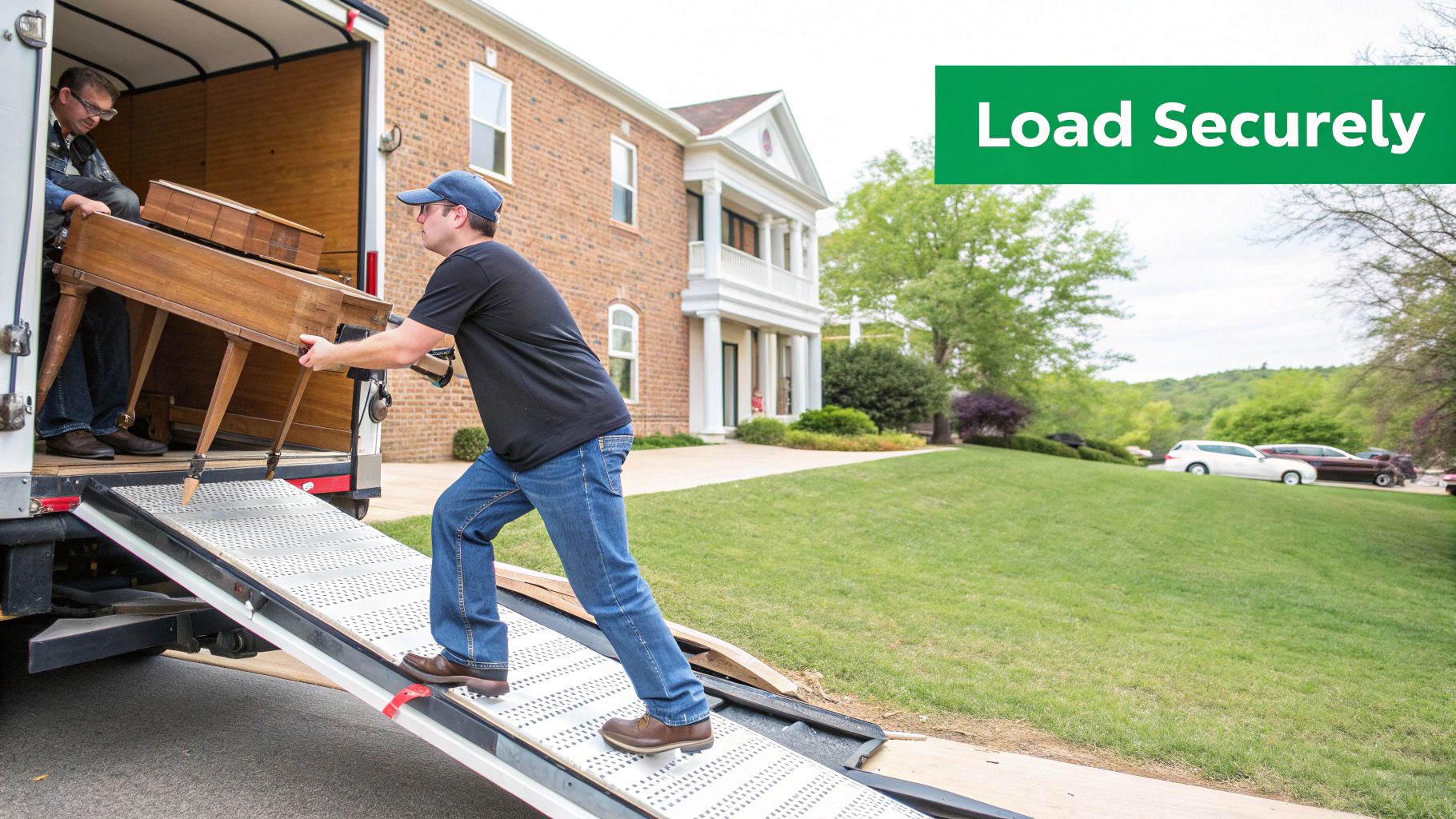Successfully moving a piano comes down to two things: smart planning and having the right gear. It's a process of measuring every doorway and hallway, wrapping the instrument in heavy-duty blankets, securing it to a specialised dolly, and using a coordinated team to get it safely into the truck. This guide covers everything you need to know for your Perth move, whether you go it alone or call in the pros.
Your Guide to Safely Transporting a Piano in Perth

Moving a piano isn't just heavy lifting. It’s a delicate operation to protect a valuable, and surprisingly fragile, musical instrument.
Maybe it's a family heirloom passed down through generations, or maybe it’s your own prized possession. Either way, the thought of it getting damaged during a move is enough to cause a lot of stress. The first step in learning how to transport a piano is really understanding what makes it such a unique challenge in the first place.
The Complexity of a Piano Move
Unlike a bookshelf or a sofa, a piano is an intricate machine with thousands of moving parts. A single bad jolt or an awkward lift can cause serious internal damage—the kind that’s expensive and sometimes even impossible to fix.
Then there's the sheer weight. We're talking anywhere from 150 kg for a small upright to well over 500 kg for a concert grand. All that weight, combined with a top-heavy and unwieldy shape, makes it one of the toughest things you could ever try to move.
Here’s a closer look at what makes them so tricky:
- Immense Weight: Pianos are incredibly dense, packing hundreds of kilos into a relatively small frame. This isn't a job for just any trolley; you need heavy-duty dollies and a team that knows proper lifting techniques to avoid injury.
- Awkward Shape: The weight is rarely distributed evenly, especially in uprights. This makes them wobbly and hard to balance on anything other than a purpose-built piano dolly.
- Fragile Internal Mechanics: Inside, you've got the action—hammers, strings, and dampers—all finely tuned and extremely sensitive to shock. Handling it the wrong way can easily knock these delicate parts out of alignment, leading to costly retuning and repairs.
- Delicate Exterior: That beautiful polished wood finish can be scratched, dented, or gouged in an instant. Using the wrong wrapping materials, or not wrapping it correctly, can leave permanent marks.
A common mistake is thinking a few strong mates can get the job done. The truth is, technique and specialised equipment trump brute force every time. Without the right approach, the risk of hurting someone or damaging the instrument is just too high.
DIY Move or Professional Removalists
When it comes to moving your piano in Perth, you've got two main choices. You could try to do it yourself, which means renting the right truck and tracking down all the necessary gear. While it might seem like the cheaper option upfront, the potential for disaster is significant.
The alternative is to hire professional piano removalists. A specialised team shows up with everything needed—skid boards, piano dollies, thick moving blankets, and secure straps. More importantly, they bring the experience to handle tricky corners, staircases, and uneven ground without breaking a sweat. They simply know how to transport a piano safely, ensuring it arrives at its new home in the exact same condition it left.
This guide will walk you through both options, giving you the insight you need to make the best decision for your situation.
Budgeting for Your Piano Move in Perth

Before you even think about lifting a single key, let’s talk about the cost. Figuring out your budget is the foundation of a smooth, stress-free move, and understanding what drives the price is the only way to make a smart decision. Several factors come into play when calculating the cost of moving a piano in Perth, and each one can nudge the final quote up or down.
The price isn't just some number plucked from the air; it's a careful calculation of the labour, specialised equipment, and risk involved. From the type and weight of your instrument to the logistics of the journey, every detail matters.
Key Factors Influencing Moving Costs
When you ring up a professional removalist for a quote, they’re going to run through a specific checklist. Your answers help them gauge the complexity of the job and give you an accurate price.
Here's what they'll need to know:
- Type of Piano: Are we talking about a compact upright or a sprawling grand piano? Grand pianos almost always need some partial disassembly and more delicate handling, which naturally costs more.
- Weight and Size: This is a big one. Heavier pianos demand more hands on deck and more robust equipment to move safely. A standard upright can weigh anywhere from 130 to 375 kg, but a grand piano can easily top 650 kg.
- Moving Distance: A quick trip across a suburb like Mount Hawthorn is going to be cheaper than a longer haul. For moves to the outer suburbs, it’s worth looking into local specialists, like our dedicated Joondalup removalists, who know the routes inside and out.
- Access Challenges: Stairs. This is probably the most common factor that adds to the cost. Every flight of stairs means more labour, more risk, and more time. Tight corners, narrow hallways, or tricky access points at either end of the move also add to the complexity and price.
Being crystal clear about these details from the start is the best way to get a quote with no nasty surprises later on.
A Look at Typical Perth Piano Moving Prices
So, what should you actually expect to pay? While every move is unique, we can look at some industry averages to get a realistic starting point.
Here's a table to give you a clearer picture of typical costs in Australia.
Estimated Piano Moving Costs in Australia
| Piano Type | Average Weight (kg) | Estimated Local Move Cost (AU$) | Estimated Interstate Move Cost (AU$) |
|---|---|---|---|
| Upright/Spinet | 130 – 230 kg | 180 – 450 | 700 – 1,200 |
| Studio Upright | 230 – 375 kg | 250 – 600 | 900 – 1,500 |
| Baby Grand | 230 – 320 kg | 500 – 800 | 1,000 – 2,000 |
| Grand | 320 – 650+ kg | 600 – 1,000+ | 1,500 – 3,000+ |
As you can see, the costs vary quite a bit. According to a 2023 report, local piano moves within a city generally cost between AUD 150 to AUD 800. A simple, straightforward local move for an upright piano usually lands in the AUD 180 to AUD 220 range. For a grand piano, which is a far more involved process, you're more likely looking at AUD 500 to AUD 800 for a local job.
These numbers really highlight why professional piano moving is a specialised trade. You’re paying for the skill and experience needed to handle such a massive, yet delicate, instrument.
Key Takeaway: The median cost for a piano move hovers around AUD 700. This price typically covers the specialised dollies, protective padding, insurance, and the muscle of an experienced crew.
The Real Cost of DIY vs. Professional Movers
It's tempting to try and save a few dollars by doing it yourself, isn't it? Before you go that route, it’s vital to weigh the true cost beyond just renting a truck. While hiring professionals has an upfront fee, it often ends up being the more sensible and economical choice.
A DIY attempt means you're on the hook for sourcing and paying for everything yourself.
The DIY Shopping List:
- Truck rental (it must have a hydraulic lift)
- A heavy-duty piano dolly
- Thick, padded moving blankets
- Heavy-duty straps and ties
- Materials to protect your floors
Once you add up those expenses and consider the time and sheer physical effort involved, the savings might not be as great as you first thought.
And here’s the most important part: with a DIY move, you assume 100% of the risk. If that piano gets dropped or damaged, the repair bill could easily eclipse what you would have paid for a professional service. Hiring an expert team isn’t just paying for labour; it’s buying peace of mind, the right gear, and in most cases, comprehensive insurance.
Getting Started: Planning and Preparation for a Flawless Piano Move
When it comes to moving a piano, a smooth operation is won or lost long before anyone lays a hand on the instrument. Honestly, proper planning is what separates a stress-free day from one filled with headaches, unexpected costs, and—worst of all—potential damage. This part of the process is all about foresight. It's about spotting challenges and having solutions ready before they turn into full-blown problems.
Think of it as creating a detailed blueprint for the move. This isn't just about giving the space a quick once-over; it requires precision, clear communication with your moving crew, and having every piece of equipment ready to go. By mapping out the entire path and protecting your property beforehand, you take all the guesswork out of the big day.
Measure Everything, Then Measure It Again
First things first, grab a tape measure. You need to get intimately familiar with your piano and the space it's in. Don't eyeball it—get the piano's exact height, width, and depth. Jot these numbers down and keep them handy.
Once you have the piano’s dimensions, it's time to chart its escape route. Measure the width of every single doorway, hallway, and staircase the piano has to go through. And don't forget the small things, like low-hanging light fixtures or that tight corner at the bottom of the stairs. It’s a classic mistake to forget the clearance needed for a hairpin turn in a stairwell.
- Doorways: Is the opening wide enough? Sometimes, you can gain a few precious centimetres just by taking the door off its hinges.
- Hallways: Look for any permanent fixtures or even bulky furniture that might narrow the path.
- Stairwells: Measure the width, of course, but also the vertical clearance. This is especially critical on landings and turns.
A piano might technically fit through a doorway straight on, but if you have to approach it at an angle, it can suddenly become impossible. I always tell people to plan for at least 10-15 cm of wiggle room on each side, just to be safe.
Clear the Path and Protect Your Home
After you’ve confirmed the route is physically possible, your next job is to make it completely clear of obstacles. This means moving all furniture, rolling up rugs, and shifting pot plants—anything that could get in the way. A clear path is a safe path. It minimises the risk of someone tripping, snagging the piano, or having an accident.
Just as important is protecting your home from damage. Pianos are incredibly heavy, and even with the most careful team, scuffs or dents can happen if you haven't taken the right precautions.
- Floors: Lay down protective runners, old blankets, or even large sheets of cardboard along the entire moving path. This is absolutely essential for timber, tile, or laminate flooring that scratches easily.
- Walls and Corners: Use painter's tape to stick some cardboard or extra padding to sharp wall corners and door frames. From my experience, these are the spots that are most likely to get dinged.
The Essential Moving Kit
Whether you're braving a DIY move or just helping out the professionals, having the right gear is non-negotiable. Trying to shift a piano without the proper tools isn't just a risk to the instrument; it’s a serious safety risk for everyone involved.
Here’s what you absolutely need:
- Heavy-Duty Piano Dolly: I’m not talking about a standard furniture dolly. A proper piano dolly is a four-wheeled, low-profile cart with a strong, often carpeted frame. It's built specifically to handle the immense weight and awkward shape of a piano.
- Thick Moving Blankets: You’ll want several of these. They need to be thick and padded to completely wrap the piano, shielding its delicate finish from any scratches or bumps.
- Heavy-Duty Straps or Webbing: These are for securing the blankets snugly around the piano and, crucially, for strapping the instrument firmly to the dolly and later on, inside the moving truck.
- Work Gloves: A solid pair of gloves with a good grip is a must for everyone on the team. They ensure a secure hold and protect your hands.
This prep work might seem like a lot, but it has a massive impact on the success of your move. For instance, in Australian cities like Melbourne, these logistical details directly affect the cost and outcome. Upright pianos, weighing anywhere from 136 to 363 kg, are a challenge, but manageable. Baby grand (227-454 kg) and full concert grand pianos (up to 544 kg) are a whole different ball game, demanding far more specialised equipment and expertise, especially since they often need to be disassembled.
The complexity of your home's layout, like navigating tight staircases in a Perth terrace house, adds another layer of difficulty and cost. This is exactly why meticulous planning is so critical. For more on how these factors play out in urban Aussie moves, it's always worth checking with moving specialists who deal with these challenges daily.
The Complete Process for Packing and Moving Your Piano
Alright, with the planning done, it’s time to roll up our sleeves. This is where the real work begins, and your careful preparation will make all the difference between a smooth move and a stressful ordeal. Let's get into the nitty-gritty of wrapping, lifting, and safely moving your piano.
The aim here is simple: lock down any moving parts, wrap the entire piano in a protective cocoon, and then move it with absolute control. From securing the lid to strapping it down in the truck, every single step is critical to prevent damage.
Securing and Wrapping Your Instrument
Before you even think about lifting anything, the piano itself needs to be prepped. The first job is to protect its most delicate and exposed parts.
Start with the keyboard lid. If it has a lock, use it. If not, close the lid and run a long piece of painter's tape to hold it shut. Crucially, never let tape touch the actual finish. Always put down a layer of plastic wrap or a soft microfibre cloth first, then tape over that. This prevents sticky residue or, even worse, pulling off the finish.
Next, it’s time to wrap the entire instrument. Grab several thick, padded moving blankets and swaddle the piano completely, covering every square inch of polished wood. You're basically creating a thick, cushioned shell. Make sure the blankets overlap generously so there are no exposed spots, paying extra attention to the vulnerable corners and legs.
Once it's wrapped, use heavy-duty moving straps or webbing to cinch the blankets down tightly. I recommend crisscrossing the straps both vertically and horizontally, pulling them taut so the padding is snug against the piano. Don't just use packing tape on the blankets; it often slips and doesn't provide nearly enough tension to be safe.
If you're looking at a mountain of boxes and feeling overwhelmed by the thought of packing an entire house, remember you can get expert help. There are professional packing services in Perth that save you time and make sure everything, not just the piano, is ready for a safe journey.

This visual gives you a quick rundown: wrap it up tight, secure it with straps, and make sure it's clearly labelled for careful handling.
Lifting and Loading onto the Dolly
With the piano wrapped like a precious gift, the real challenge begins: the lift. This is absolutely a team effort and should never be attempted alone. For a standard upright piano, you'll need at least three to four strong people.
Position one person at each end of the piano. On a clear, coordinated count (like "one, two, three, LIFT!"), tilt the piano slightly to one side. This is just enough for a third person to slide a heavy-duty piano dolly underneath, making sure it’s centred to properly balance the weight. Then, slowly and carefully lower the piano onto the dolly. It needs to be perfectly balanced to avoid becoming a wobbly, top-heavy disaster.
Now, use more straps to secure the piano to the dolly itself. This is a non-negotiable step. It physically locks the instrument to its wheels, stopping it from sliding off when you hit a bump or go down a small incline.
Expert Insight: Never try to rush a lift. The whole game is about slow, controlled movements and constant communication. Have one person act as the team leader, giving clear commands for every lift, tilt, and roll. This ensures everyone moves as one.
Navigating Your Home with Care
Rolling the piano through your house requires a steady hand and a lot of patience. The team leader should walk ahead, scouting the path and calling out obstacles you identified earlier—door thresholds, tight corners, and any narrow hallways.
- Corners: Approach sharp corners slowly. You’ll probably need to do a multi-point turn, inching the dolly back and forth to clear the corner without taking a chunk out of your wall.
- Thresholds: Don't try to ram over door thresholds. Instead, get a bit of momentum and lift the dolly wheels slightly to pop them over the bump. Even a small jolt can be enough to rattle the piano's internal mechanics.
- Stairs: This is the most dangerous part of any DIY piano move. If you have more than two or three steps, a ramp is a must-have. For a full staircase, you really need specialised equipment and professional expertise to avoid a catastrophic accident.
Securing the Piano in the Moving Truck
Once you've made it outside, the next hurdle is getting it safely into the truck. A truck with a hydraulic lift is the best-case scenario. If you're using a ramp, make sure it’s not too steep and that you have people pushing from behind while another person guides it from the front.
Inside the truck, the piano should be positioned against the back wall (the one right behind the cab). This is the most stable place for it. Place it with the keys facing the wall for maximum protection.
Use at least two ratchet straps to anchor the piano firmly to the truck's internal tie-down points. The instrument should have zero room to move, slide, or even jiggle. Any movement during transit is a recipe for disaster. For extra stability, pack other heavy furniture or sturdy boxes around it to brace it further.
Finally, unloading is simply this entire process in reverse: carefully unstrap, slowly roll it down the ramp, navigate it into the new home, and gently lift it off the dolly into its final resting place.
How to Handle International Piano Transport to Australia

Bringing a piano to Perth from another country isn't just a big move; it's a major logistical undertaking. You're suddenly dealing with international freight, complex customs procedures, and some of the world's strictest biosecurity rules. This is where you quickly realise that hiring a professional international mover isn't a luxury—it's an absolute necessity.
The long journey across oceans exposes your instrument to all sorts of risks, from wild swings in temperature and humidity to the relentless vibrations of transit. A specialised international mover knows exactly how to manage this, safeguarding your piano from your old front door to your new one in Australia.
The Non-Negotiable Step: Professional Crating
Forget simply wrapping the piano in moving blankets. For an international trip, that just won't do. The only truly reliable method is custom crating. And I don't mean a generic wooden box.
A proper international mover will build a crate specifically for your piano's exact dimensions. Inside, it’s lined with high-density, shock-absorbent foam to stop it from shifting and to cushion it from the bumps and vibrations of the journey. This level of bespoke protection is what ensures your piano arrives in one piece.
Navigating Australian Customs and Quarantine
Australia's biosecurity laws are no joke, and a piano can easily get caught up in red tape if you aren't prepared. Every single shipment gets inspected by the Australian Border Force and the Department of Agriculture, Water and the Environment.
Here's what you'll be up against:
- Wood Treatment: The crate itself, and any raw wood on the piano, must meet ISPM 15 standards. This means the wood has been treated to kill any foreign pests. Your shipping company will handle the certification, but it's a critical step.
- Ivory Keys: Own an antique piano with ivory keys? You'll need a CITES permit (Convention on International Trade in Endangered Species of Wild Fauna and Flora) to legally import it. This can be a long process and requires solid proof of the instrument's age.
- Documentation: Prepare for a mountain of paperwork. We're talking detailed inventories, bills of lading, and import declarations. One mistake can lead to frustrating delays, steep storage fees, or, in the worst-case scenario, your piano being seized.
International piano transportation to Australia is a detailed and carefully managed process, particularly for grand or antique instruments. Professional movers handle this complexity by wrapping the piano, securing it in a climate-controlled vehicle, and then building a custom crate with shock-absorbent lining at their warehouse. They manage all the critical customs paperwork, ensuring compliance with Australia's unique import restrictions, like those for ivory, and strict quarantine controls. Discover more insights about this specialised international freight handling from experts at MoverstoAustralia.com.
Sea Freight Versus Air Freight
You’ve got two main choices for getting your piano to Australian shores. Each has its own distinct trade-offs between cost and speed.
| Feature | Sea Freight | Air Freight |
|---|---|---|
| Cost | Significantly more affordable. | Much more expensive, often several times the price of sea freight. |
| Transit Time | Slower, typically taking 4-8 weeks depending on the origin. | Faster, usually taking 1-2 weeks from collection to delivery. |
| Environment | More stable for the instrument due to fewer pressure and temperature fluctuations. | Can expose the piano to rapid changes in air pressure and climate. |
| Best For | Budget-conscious moves where time is not the primary concern. | Urgent moves or extremely high-value instruments where speed is critical. |
For most people, sea freight provides the best balance of safety and value. The slow, steady journey is actually gentler on a piano’s delicate timber and intricate internal mechanics.
One last thing: comprehensive transit insurance is essential. Don't even think about shipping without it. Make sure your policy covers the full replacement value of the piano and protects against damage, loss, and any problems that might pop up during customs inspections. When you’re moving a piano internationally, good insurance is your ultimate safety net.
Getting Your Piano Settled In After the Move
Alright, the piano is inside and the heavy lifting is over. But your job isn’t quite finished. Getting the piano into its new room is only half the battle; now comes the crucial part of helping it settle in. Skipping this stage can undo all the careful work you’ve just put in.
Think about what your piano has just been through. It’s been carefully wrapped, tilted on its side, wheeled through doorways, and experienced shifts in temperature along the way. It needs a little time to recover and adjust to its new surroundings, much like we do after a big trip.
Give It Time to Acclimatise
First things first: resist the urge to call a piano tuner straight away. You need to let the instrument rest and get used to its new home. This isn't just a suggestion—it's essential.
Plan for a settling-in period of at least two to four weeks. During this time, the timber, the soundboard, and all the intricate metal parts inside are slowly expanding or contracting to match the room's specific temperature and humidity. If you tune it too soon, it’s just a waste of money. The pitch will drift again as the piano continues to acclimatise, and you'll just have to get it tuned a second time. A little patience now pays off with a much more stable and lasting tuning later.
Finding the Perfect Spot in the Room
Where you place your piano is probably the single most important decision for its long-term health. A bad spot can lead to serious, sometimes irreversible, damage over the years, impacting everything from the finish to the tuning stability.
The golden rule for piano placement is simple: find a stable environment. Your goal is to find a spot with the least amount of temperature and humidity fluctuation. It’s a small choice that has a massive impact on your instrument’s lifespan.
When you're scouting for the ideal location, here’s what you absolutely need to avoid:
- Direct Sunlight: Keep it well away from windows where the sun beats in. UV rays will fade and damage the beautiful wood finish, and the intense heat can cause the timber to warp or even crack.
- Heating and Cooling Vents: Never place a piano right next to a vent. The constant blasts of hot or cold air force the wood to expand and contract, which is a nightmare for holding a tune.
- Drafty Windows and Doors: Just like vents, drafts create sudden temperature changes that put a huge amount of stress on the instrument's structure.
- Exterior Walls: Whenever possible, an interior wall is your best bet. Exterior walls tend to be colder and more susceptible to the humidity shifts from outside.
Following these final steps ensures your piano doesn't just survive the move but is set up to thrive for years to come. It’s the finishing touch that protects your investment. This is just as vital as making sure you were covered during the transport itself. For more on that, our article on essential insurance tips for a stress-free move is a great resource for extra peace of mind.
Got Questions About Moving Your Piano? We've Got Answers
Even the most carefully planned piano move can leave you with a few lingering questions. It's completely normal. After all, this isn't your average piece of furniture. Let's walk through a couple of the most common queries we hear from folks around Perth.
Can a Piano Be Moved on Its Back?
This is a big one, and the answer for an upright piano is a hard and fast no. It might seem like a stable way to move it, but laying an upright flat on its back places all of its immense weight on the internal workings and the back panel. These parts were never built to take that kind of stress and you risk serious, expensive damage.
Your upright piano must stay upright throughout the entire move.
Grand pianos are a different story. They are almost always moved on their side, but only after a professional has carefully detached the legs and pedals and wrapped everything securely.
Does My Piano Need Tuning Right After the Move?
It's tempting to get it tuned immediately so you can start playing, but you really need to hold off. Pianos are sensitive to changes in their environment, and yours will need time to adjust to the new room's specific temperature and humidity levels.
It’s best to give your piano at least two to four weeks to acclimatise before you even think about calling a tuner. Tuning it any sooner is usually a waste of money because the strings will continue to stretch and settle as the instrument gets used to its new home.
Letting it rest first means the tuning will be more stable and last much longer.
When it's time for your next move, don't leave your precious items to chance. For a seamless and stress-free relocation in Perth, trust the experienced team at Emmanuel Transport. Get your transparent, no-obligation quote today.













